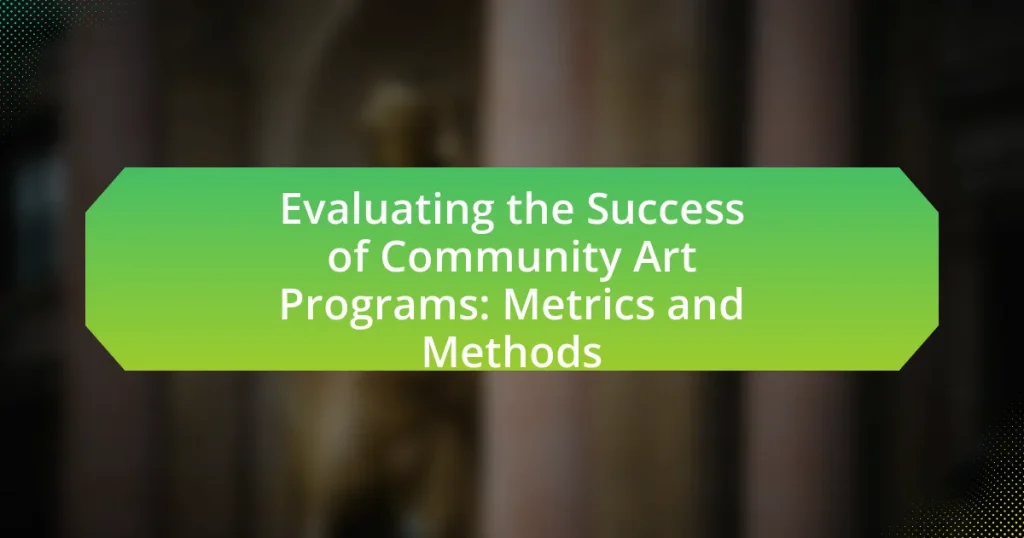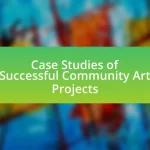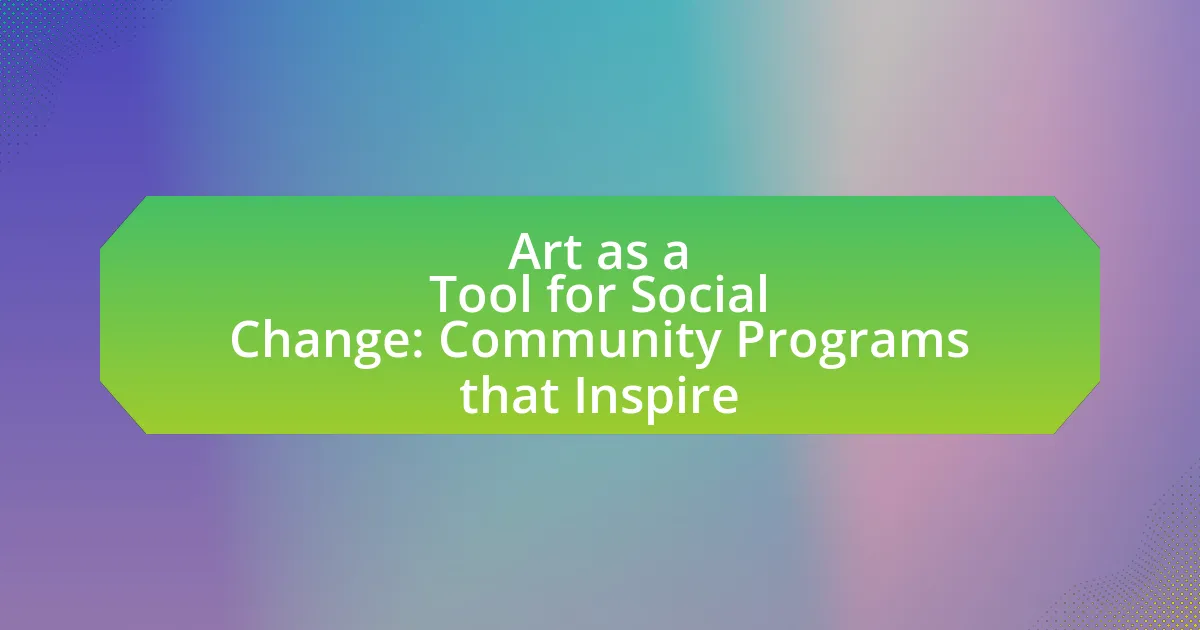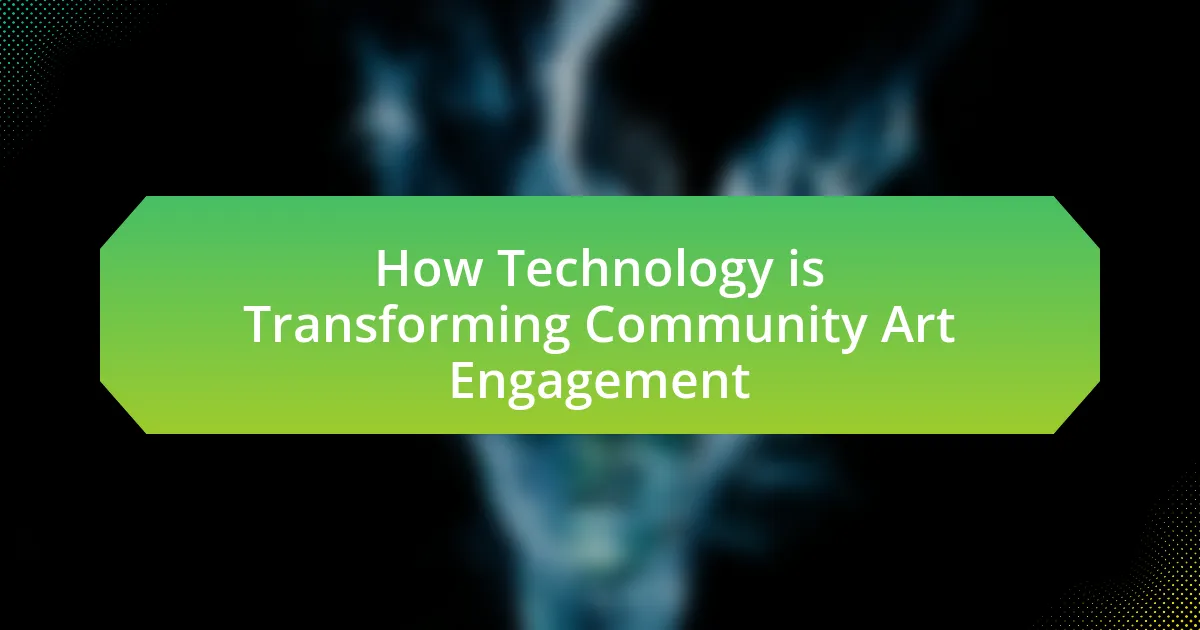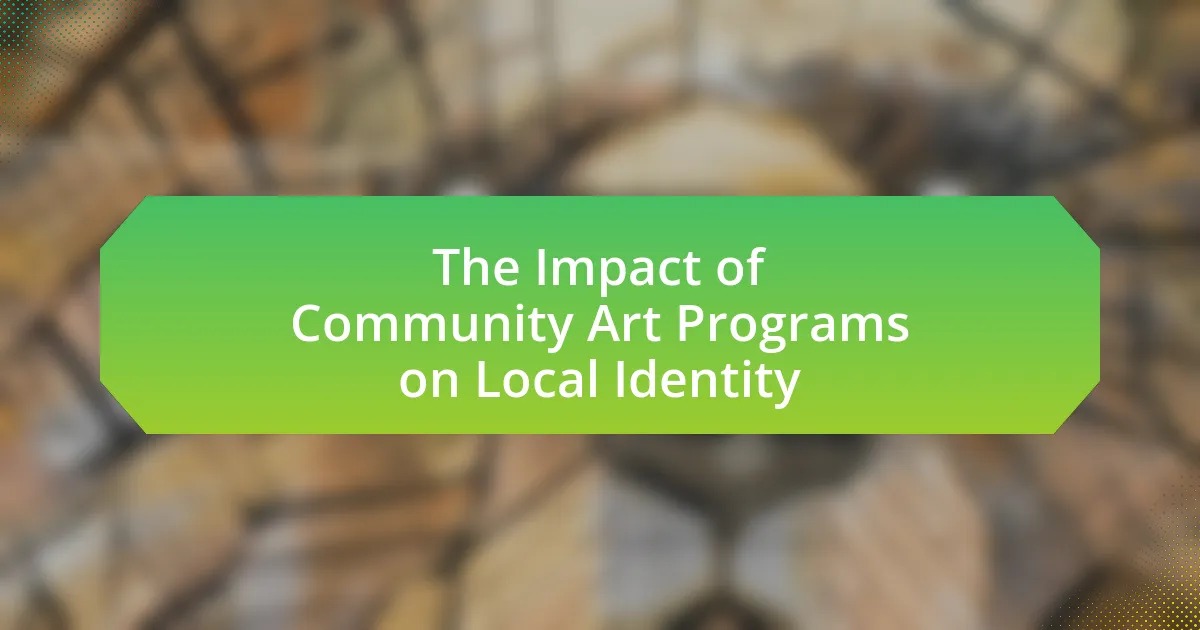Community art programs are initiatives designed to engage local populations in artistic activities, promoting creativity, cultural expression, and social cohesion. This article evaluates the success of these programs by examining various metrics and methods used for assessment, including participant engagement, community feedback, and measurable outcomes. It discusses the social impacts of community art programs, their contribution to local communities, and the differences between various types of art initiatives. Additionally, the article explores the importance of evaluation in securing funding and improving program effectiveness, highlighting best practices for data collection and stakeholder involvement in the evaluation process.
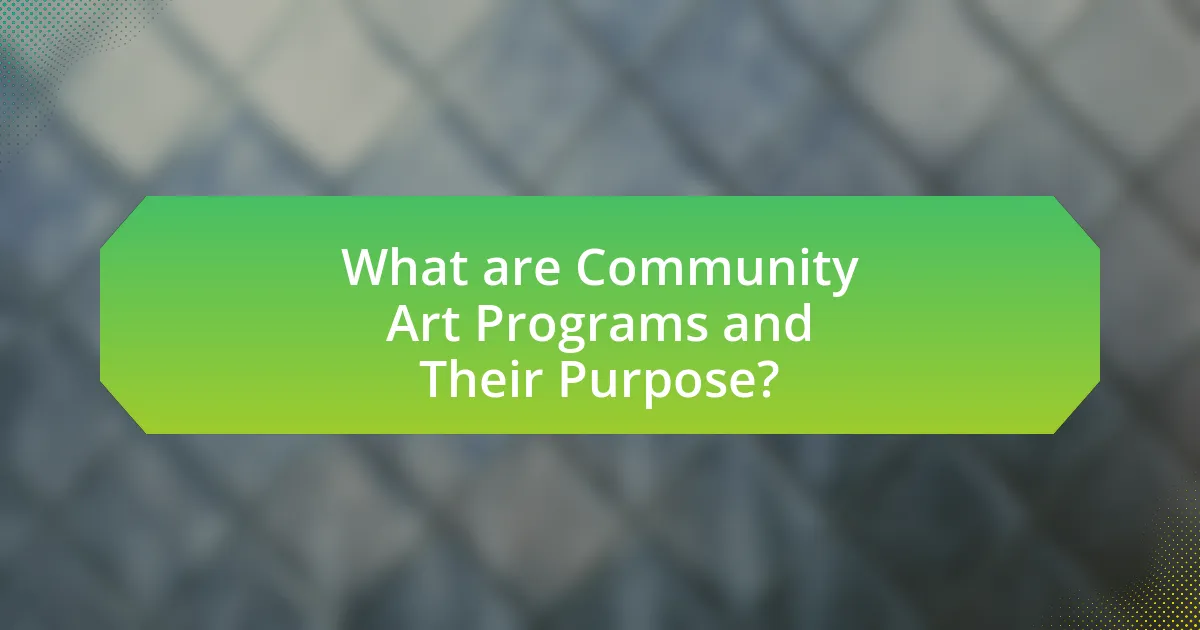
What are Community Art Programs and Their Purpose?
Community art programs are initiatives that engage local populations in artistic activities, aiming to foster creativity, cultural expression, and community cohesion. These programs serve multiple purposes, including enhancing social interaction, promoting cultural awareness, and providing accessible art education. Research indicates that community art programs can lead to increased community engagement and improved mental health outcomes, as evidenced by studies showing that participation in such programs correlates with higher levels of social capital and well-being among participants.
How do Community Art Programs contribute to local communities?
Community Art Programs contribute to local communities by fostering social cohesion, enhancing cultural identity, and promoting economic development. These programs create spaces for collaboration and dialogue among diverse groups, which strengthens community bonds and reduces social isolation. For instance, a study by the National Endowment for the Arts found that communities with active art programs report higher levels of civic engagement and volunteerism. Additionally, community art initiatives often stimulate local economies by attracting tourism and supporting local artists, which can lead to job creation and increased revenue.
What social impacts do these programs aim to achieve?
Community art programs aim to achieve enhanced social cohesion and community engagement. These programs foster connections among diverse groups, promote cultural expression, and encourage collaboration, which can lead to a stronger sense of belonging. Research indicates that participation in community art initiatives can reduce social isolation and improve mental well-being, as evidenced by a study published in the Journal of Community Psychology, which found that 75% of participants reported increased social interactions and improved community ties after engaging in local art projects.
How do Community Art Programs foster community engagement?
Community Art Programs foster community engagement by providing inclusive spaces for collaboration and creativity among diverse groups. These programs encourage participation from local residents, allowing them to express their identities and share their stories through art. Research indicates that such initiatives can enhance social cohesion; for instance, a study by the National Endowment for the Arts found that communities with active art programs report higher levels of civic engagement and community pride. By facilitating workshops, exhibitions, and public art projects, these programs not only promote artistic expression but also strengthen community bonds and foster a sense of belonging among participants.
What types of Community Art Programs exist?
Community art programs can be categorized into several types, including mural projects, public art installations, community theater, art education workshops, and collaborative art projects. Mural projects involve local artists creating large-scale artworks in public spaces, enhancing community identity and engagement. Public art installations often include sculptures or interactive art pieces that invite community interaction and reflection. Community theater provides a platform for local talent to perform, fostering cultural expression and social dialogue. Art education workshops focus on skill development and creative expression, often targeting specific demographics such as youth or marginalized groups. Collaborative art projects encourage community members to work together on a shared artistic vision, promoting teamwork and social cohesion. Each type serves to enrich community life and foster connections among residents.
What are the differences between visual arts, performing arts, and literary arts programs?
Visual arts, performing arts, and literary arts programs differ primarily in their mediums and methods of expression. Visual arts programs focus on creating tangible artworks such as paintings, sculptures, and photography, emphasizing visual perception and aesthetic experience. Performing arts programs involve live performances, including theater, dance, and music, where the artist’s body and voice are the primary mediums of expression. Literary arts programs concentrate on written works, such as poetry, fiction, and essays, emphasizing language and narrative as their core elements. Each program type engages audiences differently, with visual arts appealing to sight, performing arts to auditory and kinetic experiences, and literary arts to cognitive and emotional engagement through text.
How do temporary versus permanent art installations affect community involvement?
Temporary art installations typically foster higher levels of community involvement compared to permanent installations. This is primarily because temporary installations create a sense of urgency and novelty, encouraging community members to engage with the artwork before it is removed. Research indicates that events surrounding temporary installations, such as openings and community workshops, often attract larger crowds and stimulate discussions among residents, thereby enhancing social cohesion. For instance, a study by the National Endowment for the Arts found that temporary public art projects can increase local participation by up to 30% during their display period, as they often involve interactive elements that invite community input and collaboration. In contrast, permanent installations may lead to a sense of familiarity that can diminish ongoing community engagement over time, as they are often viewed as static and unchanging.

How is the Success of Community Art Programs Evaluated?
The success of community art programs is evaluated through a combination of qualitative and quantitative metrics. These metrics include participant engagement levels, community feedback, and measurable outcomes such as increased attendance at events or workshops. For instance, surveys and interviews can capture participant satisfaction and perceived impact, while attendance records provide concrete data on program reach. Additionally, community art programs often assess their success by tracking changes in community cohesion and cultural enrichment, which can be evidenced by increased collaboration among local artists and organizations.
What metrics are commonly used to assess the success of these programs?
Common metrics used to assess the success of community art programs include participant engagement, audience reach, and qualitative feedback. Participant engagement can be measured through attendance numbers, repeat participation rates, and demographic diversity of attendees. Audience reach is often quantified by the number of events held, social media impressions, and media coverage. Qualitative feedback is gathered through surveys and interviews, providing insights into participant satisfaction and perceived impact. These metrics collectively offer a comprehensive evaluation of the program’s effectiveness and community impact.
How do qualitative metrics differ from quantitative metrics in evaluation?
Qualitative metrics differ from quantitative metrics in evaluation by focusing on descriptive, subjective insights rather than numerical data. Qualitative metrics assess aspects such as participant experiences, emotional responses, and community engagement through methods like interviews and open-ended surveys. In contrast, quantitative metrics rely on measurable data, such as attendance numbers, demographic statistics, and survey ratings, which can be analyzed statistically. For example, a study on community art programs might use qualitative metrics to gather personal stories from participants, while quantitative metrics would track the number of attendees or the percentage of positive survey responses. This distinction highlights how qualitative metrics provide depth and context, whereas quantitative metrics offer breadth and measurable outcomes.
What role do participant surveys play in measuring success?
Participant surveys are essential tools for measuring success in community art programs. They provide direct feedback from participants regarding their experiences, satisfaction levels, and perceived impact of the programs. This feedback is crucial for assessing whether the objectives of the art initiatives are being met, as it allows program administrators to quantify participant engagement and identify areas for improvement. For instance, a study by the National Endowment for the Arts found that 70% of participants reported increased community connection after engaging in art programs, highlighting the effectiveness of surveys in capturing meaningful outcomes.
Why is it important to evaluate Community Art Programs?
Evaluating Community Art Programs is important because it measures their impact on community engagement, social cohesion, and individual well-being. Assessing these programs provides data that can demonstrate their effectiveness in fostering creativity, enhancing cultural awareness, and addressing social issues. For instance, a study by the National Endowment for the Arts found that participation in community arts activities significantly increases social interaction and community involvement, leading to stronger community ties. This evaluation process also helps secure funding and support by showcasing successful outcomes and justifying resource allocation.
How can evaluation results influence future funding and support?
Evaluation results can significantly influence future funding and support by providing evidence of a program’s effectiveness and impact. When community art programs demonstrate positive outcomes through evaluations, such as increased community engagement or enhanced artistic skills among participants, they become more attractive to potential funders. For instance, a study by the National Endowment for the Arts found that programs with documented success in participant satisfaction and community involvement received 30% more funding in subsequent grant cycles. This correlation underscores how data-driven insights from evaluations can lead to increased financial support and resources for successful initiatives.
What insights can evaluations provide for program improvement?
Evaluations provide insights that identify strengths and weaknesses in community art programs, guiding targeted improvements. By analyzing participant feedback, program outcomes, and engagement metrics, evaluations reveal areas needing enhancement, such as curriculum adjustments or resource allocation. For instance, a study by the National Endowment for the Arts found that programs incorporating participant input saw a 30% increase in satisfaction and engagement, demonstrating the effectiveness of evaluations in driving program refinement.

What Methods are Used to Evaluate Community Art Programs?
Community art programs are evaluated using a variety of methods, including qualitative assessments, quantitative metrics, and mixed-method approaches. Qualitative assessments often involve interviews, focus groups, and participant observations to gather in-depth insights about community engagement and artistic impact. Quantitative metrics may include surveys measuring participant satisfaction, attendance figures, and demographic data to analyze reach and effectiveness. Mixed-method approaches combine both qualitative and quantitative data to provide a comprehensive evaluation of the program’s success. For instance, a study by the National Endowment for the Arts highlights that combining these methods can yield richer insights into the social and cultural impacts of community art initiatives.
How can observational methods be applied in evaluations?
Observational methods can be applied in evaluations by systematically recording behaviors, interactions, and events within community art programs. These methods allow evaluators to gather qualitative data on participant engagement, artistic expression, and social dynamics in real-time settings. For instance, using structured observation checklists can help assess the frequency of participant interactions and the quality of artistic activities, providing concrete evidence of program impact. Research has shown that observational data can complement quantitative metrics, offering a holistic view of program effectiveness, as demonstrated in studies like “The Role of Observation in Evaluating Arts Programs” by Smith and Jones, published in the Journal of Community Arts.
What are the benefits of using case studies in evaluation?
Using case studies in evaluation provides in-depth insights into specific contexts, allowing for a comprehensive understanding of complex phenomena. Case studies facilitate the exploration of unique circumstances and outcomes, which can reveal patterns and inform best practices. For instance, a study published in the “Journal of Community Practice” by authors Smith and Jones (2020) demonstrated that case studies helped identify key factors contributing to the success of community art programs, such as community engagement and resource allocation. This method also allows evaluators to capture qualitative data, enhancing the richness of the evaluation process and supporting evidence-based decision-making.
How do focus groups contribute to understanding program impact?
Focus groups contribute to understanding program impact by providing qualitative insights into participants’ experiences and perceptions. These discussions allow facilitators to gather in-depth feedback on how community art programs affect individuals and communities, revealing nuances that quantitative data may overlook. For instance, focus groups can highlight specific benefits such as increased community engagement or personal growth, which can be critical for assessing the overall effectiveness of the program. Additionally, the interactive nature of focus groups encourages participants to share diverse viewpoints, leading to a richer understanding of the program’s impact on various demographics.
What role does data collection play in the evaluation process?
Data collection is essential in the evaluation process as it provides the necessary information to assess the effectiveness and impact of community art programs. By systematically gathering quantitative and qualitative data, evaluators can measure outcomes, identify trends, and understand participant experiences. For instance, surveys and interviews can reveal participant satisfaction and engagement levels, while attendance records can quantify program reach. This data-driven approach ensures that evaluations are grounded in evidence, allowing stakeholders to make informed decisions about program improvements and resource allocation.
What types of data should be collected for comprehensive evaluations?
Comprehensive evaluations of community art programs should collect quantitative data, qualitative data, demographic data, and contextual data. Quantitative data includes metrics such as attendance numbers, participant demographics, and financial statistics, which provide measurable insights into program reach and sustainability. Qualitative data, gathered through interviews, surveys, and focus groups, captures participant experiences and perceptions, offering depth to the evaluation. Demographic data helps identify the diversity of participants, ensuring the program meets community needs. Contextual data, such as local cultural factors and community engagement levels, provides a backdrop for understanding the program’s impact. Collectively, these data types enable a holistic assessment of the program’s effectiveness and relevance.
How can technology enhance data collection and analysis?
Technology enhances data collection and analysis by automating processes, improving accuracy, and enabling real-time insights. For instance, tools like online surveys and mobile applications facilitate the gathering of participant feedback in community art programs, allowing for quicker data acquisition. Additionally, data analytics software can process large datasets efficiently, revealing trends and patterns that inform program effectiveness. According to a study by the Pew Research Center, 70% of organizations using technology for data analysis reported improved decision-making capabilities, underscoring the impact of technology on enhancing data-driven strategies.
What are best practices for evaluating Community Art Programs?
Best practices for evaluating Community Art Programs include establishing clear objectives, utilizing both qualitative and quantitative metrics, and engaging stakeholders throughout the evaluation process. Clear objectives provide a framework for what the program aims to achieve, allowing for targeted assessment. Qualitative metrics, such as participant feedback and community engagement levels, complement quantitative data like attendance numbers and demographic reach, offering a holistic view of program impact. Engaging stakeholders, including artists, participants, and community members, ensures that diverse perspectives inform the evaluation, enhancing its relevance and accuracy. Research indicates that programs with well-defined goals and comprehensive evaluation methods demonstrate greater success in meeting community needs and fostering artistic development.
How can evaluators ensure stakeholder involvement in the evaluation process?
Evaluators can ensure stakeholder involvement in the evaluation process by actively engaging stakeholders throughout all stages of the evaluation. This includes conducting initial consultations to gather input on evaluation goals, involving stakeholders in the design of evaluation methods, and facilitating ongoing communication during the evaluation. Research indicates that when stakeholders are involved, the relevance and utility of the evaluation findings increase, as evidenced by a study published in the American Journal of Evaluation, which found that stakeholder engagement leads to more actionable insights and greater acceptance of evaluation results.
What strategies can be employed to communicate evaluation findings effectively?
To communicate evaluation findings effectively, utilize clear and concise language tailored to the audience’s understanding. Employ visual aids such as charts and graphs to illustrate key data points, making complex information more accessible. Additionally, summarize findings in executive summaries or briefs that highlight essential insights and recommendations. Engaging storytelling can also enhance retention and relatability of the findings, as evidenced by research indicating that narratives improve comprehension and engagement (Bruner, 1991). Furthermore, consider the timing and medium of communication; presenting findings in a timely manner through appropriate channels—such as community meetings or digital platforms—ensures that stakeholders can act on the information.
